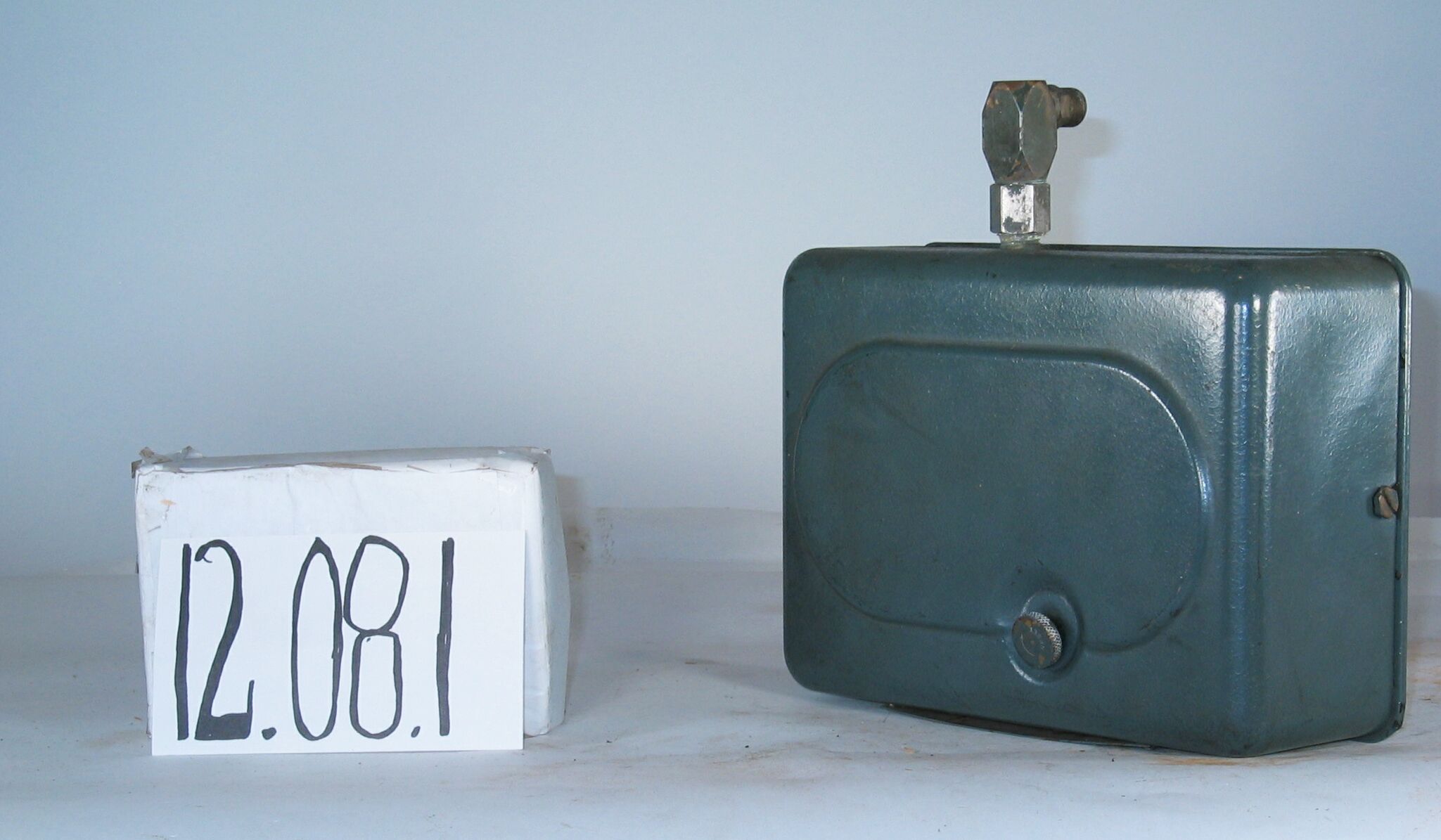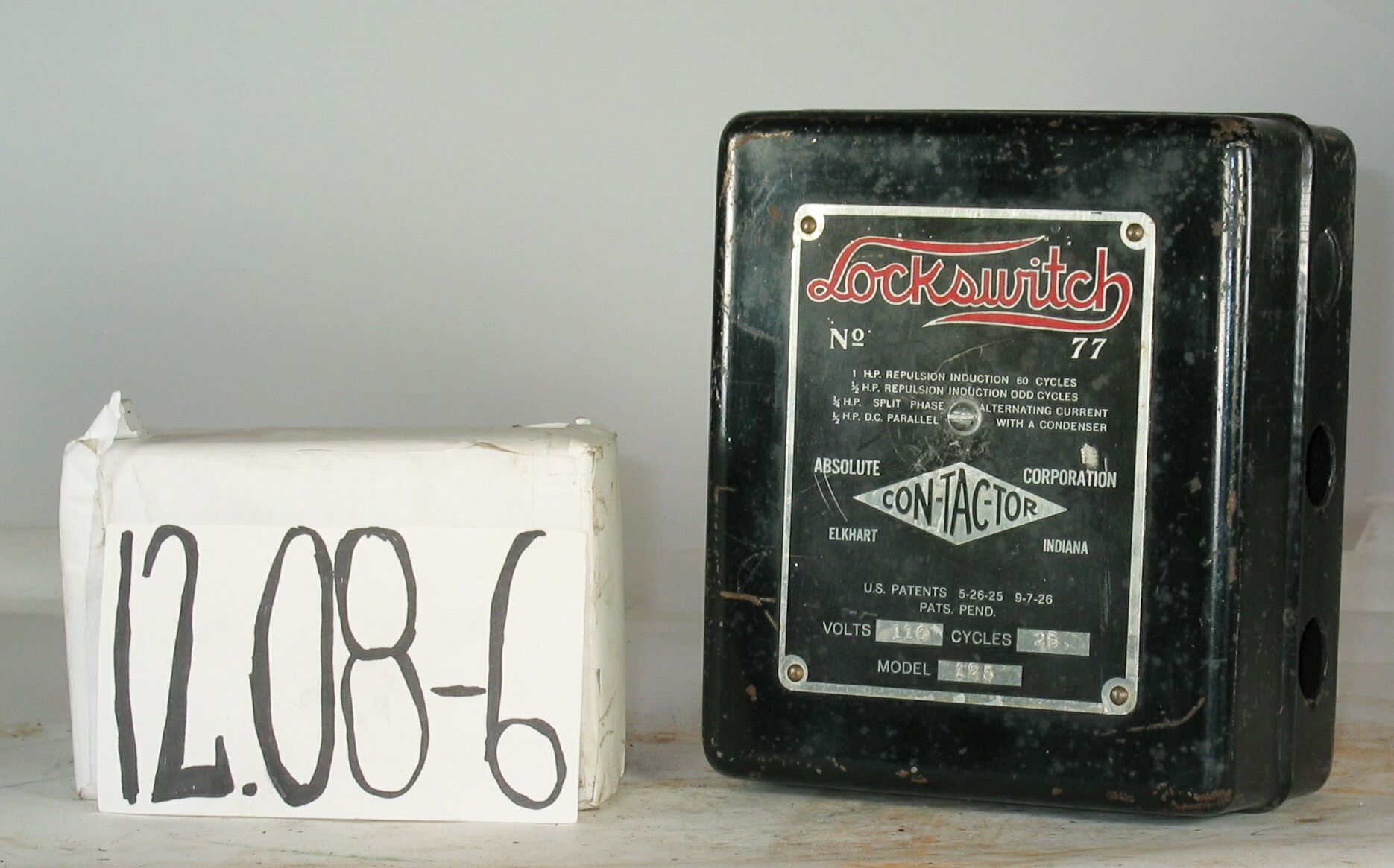12.08-8: Minneapolis Honeywell 1948 'Protectostat' Radiant Heat Sensor

| HHCC Accession No. 2006.109 | HHCC Classification Code: 12.08-8 |
|---|
Description:
The ‘Protectostat’, a late 1940’s radiant heat sensor for combustion safety control. It would set new standard for combustion safety for higher firing rate, oil atomizing heating systems found in large Canadian estate homes, institutions and small industrial applications. Sited directly on the fire, it used a black metal diaphragm to mechanically actuate a low voltage control system through a Minneapolis Honeywell ‘Protectorelay’, Minneapolis Honeywell, Type A, Circa 1948.
Group:
12.08 Pressure Atomizing Oil Burner Equipment and Systems - Fuel Flow and Combustion Controls
Make:
Minneapolis Honeywell
Manufacturer:
Minneapolis Honeywell Regulator Co.
Model:
Type A ——C57A check 080314’.
Serial No.:
Size:
5’ round x 8 ‘ long
Weight:
6 lbs.
Circa:
1948
Rating:
Exhibit, education, and research quality, illustrating the engineering and design of mid 20th century automatic combustion safety control systems, using radiant heat sensors
Patent Date/Number:
Provenance:
From York County (York Region) Ontario, once a rich agricultural hinterlands, attracting early settlement in the last years of the 18th century. Located on the north slopes of the Oak Ridges Moraine, within 20 miles of Toronto, the County would also attract early ex-urban development, to be come a wealthy market place for the emerging household and consumer technologies of the early and mid 20th century.
This artifact was discovered in the 1950’s in the used stock of T. H. Oliver, Refrigeration and Electric Sales and Service, Aurora, Ontario, an early worker in the field of agricultural, industrial and consumer technology.
This particular control was used on a residential heating system in York County [York Region], North of Toronto during the 1930’s.
Type and Design:
Employs radiant heat sensor Uses a black metal diaphragm to mechanically actuate a low voltage snap action switch Sites directly on the fire,
Operates through a Minneapolis Honeywell electro-magnetic ‘Protectorelay’.
Construction:
Material:
Special Features:
Handsome corporate name plate and logo in red, black and chrome
Accessories:
Original wiring box connector for metal shielded cable
Capacities:
Performance Characteristics:
Operation:
Control and Regulation:
Targeted Market Segment:
Consumer Acceptance:
Merchandising:
Market Price:
Technological Significance:
Mounted adjacent to the burner fire tube, the device immediately sensed the radiant heat of combustion, providing here-to-for unheard of rapid response needed for the safe and satisfactory operation of larger oil fired boilers and furnaces, operating in the range of 3 to 12 gallons per minute of number 2 or 3 fuel oil.
The Protectostat operated a Minneapolis Protectorelay, consisting of electro-magnetic switches and a thermal safety, automatic cut out timing device. The Protectostat with Protectorelay would become the standard of the industry for institutional and small commercial and industrial, automatic oil fired systems until the introduction of photo-electric eye, electronic sensing technology in the 1950’s, see reference. These embryonic, electric automated systems were representative of the early introduction of complex systems into Canadian homes and places of business. See Note #2
Industrial Significance:
The potential explosive power of several gallons per minute of high pressure vapourized fuel oil being sprayed into a combustion chamber is awesome and a source of fear to system owners, operators and service people alike. The importance of fast response for safety shut down in case of delayed ignition on unattended, automatic systems is paramount. The development of the radiant heat sensor opened up new applications for automatic operation of boilers, where operating engineers in constant attendance became unnecessary under certain conditions.
Socio-economic Significance:
Socio-cultural Significance:
Donor:
G. Leslie Oliver, The T. H. Oliver HVACR Collection
HHCC Storage Location:
Tracking:
Bibliographic References:
Minneapolis Honeywell, Installation Instruction, Protectostat, Type C57A, November 1946 Minneapolis Honeywell, Installation Instruction, Protectorelay, Type R114, Feb. 1947 Minneapolis Honeywell, Installation Instruction, Photo cell mount, Type C7003A, August 1954
References Cybernetcs and General Systems [Oliver Collection]: Systems Engineering Tools, Harold Chestnut, 1966. Modern Systems Research for the Behavioral Scientist, Walter Buckley, Editor, Aldine, 1968. Systems Behaviour, John Beishon and Geoff Peters, Harper and Row, 1972 Systems Engineering Methods, Harold Chestnut, Wiley, 1977
Notes:
- The Introduction of Popular, Complex Systems into the Canadian Home:
The 1920’s saw the introduction of complex mechanical, electric and electronic systems into the Canadian home and the lives of many Canadians, most of them ill prepared. For the first time the public would experience, as an inherent part of their daily life’s routines, the benefits, as well as all too often the vagaries of systems engineering ‘ then in an embryonic state of development. The level of dependence on such systems, with all their inherent imperfections and attendant risks, would be no more apparent than in the field of automatic home heating.
These systems were at once intimidating, awe inspiring, often the source of feelings of personal ineptitude, as well as of fear for reasons of personal and property safety. Included in the early rush to popular technology systems were the automobile, the household radio and automatic home heating. But the most intimidating was, in many ways the latter, immensely obtrusive, in your face, larger than life, and all around you 24 hours a day, bringing with it a degree of dependency that the householder could not afford to forget in the dead of a Canadian winter. All three of these pieces of technology [the automobile, the household radio and the automatic home heating system], have in common an elaboration of interconnected and interdependent parts on which the integrity and performance of the system would be desperately dependent. For the automatic home heating system these components, each with its own unique integrity and operating characteristics, would include, for example: electric motors, flame sensors, solenoid valves, pressure sensors and actuators, electric ignition transformers, heat detecting devices and thermostats. The advent of such increasingly complex, automated systems [mechanical, electric, and electronic] would, in fact, by the late 1940’s lead to a new specialized field of study, known at that time as ‘Cybernetics’, and thence to the larger field of ‘general systems’. The focus was on coming to understand better the properties and performance of complex, inanimate systems, including their degree of purposefulness, self regulation and self direction setting, as well as their ability to communicate meaningful information within the network of which they were a part. For each component of the system must communicate effectively with others for the system to function safely and satisfactorily. System performance, stability, reliability and maintainability, among other criteria, were at stake. All of these criteria were of fundamental importance in the development of automated heating systems for the Canadian homeowner, and the inventors and manufacturers of the day knew it. [See References, General Systems] For their part the manufacturers of these systems, with their myriad component parts and complexities, would learn from the outset the importance of trained service people in communities across the country, wherever such systems would appear. By the 1940’s training courses were increasingly common, as well as control and systems handbooks and systems trouble shooting guides provided by equipment and systems manufacturers.
Related Reports:
CMX02 Item H12











